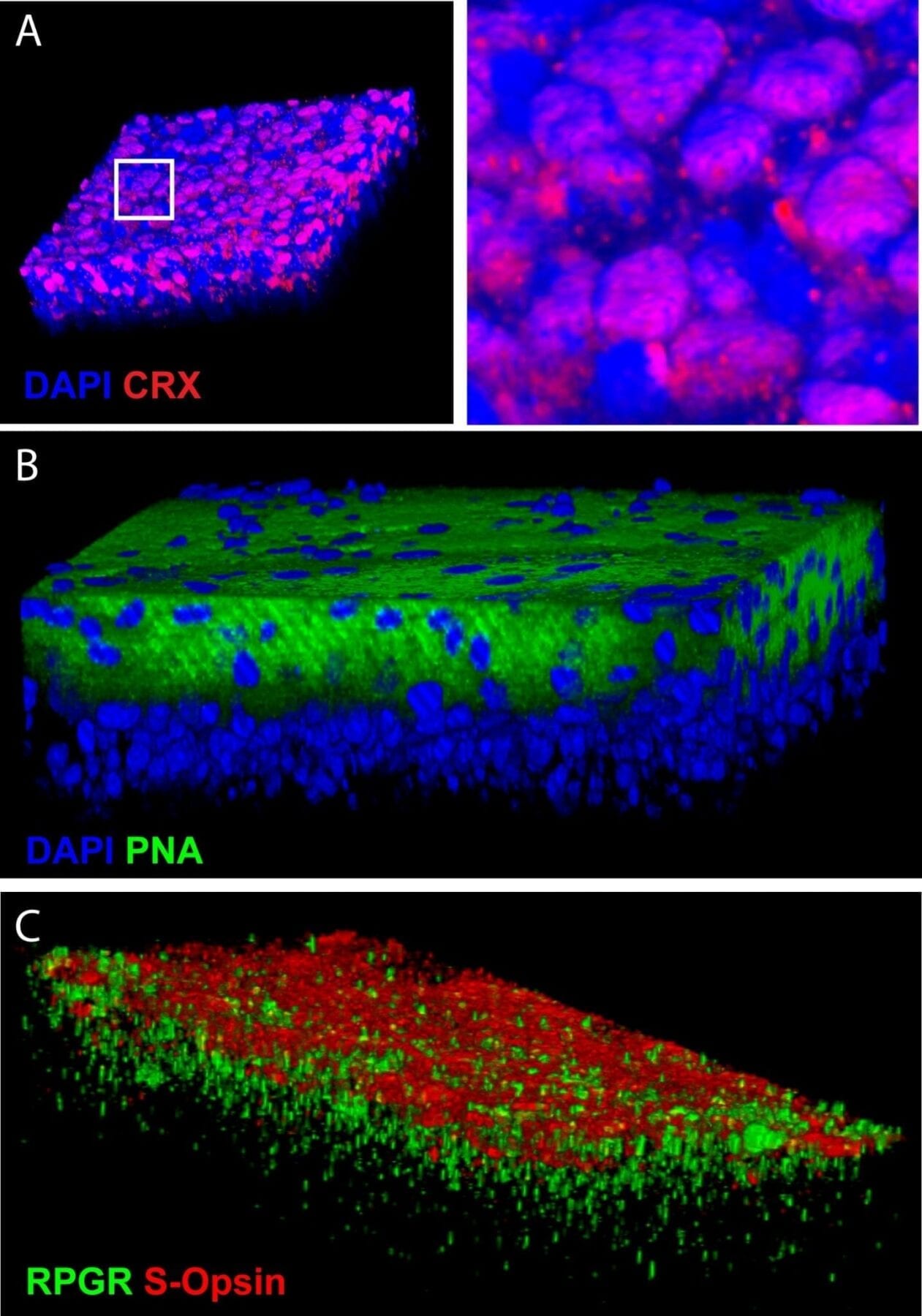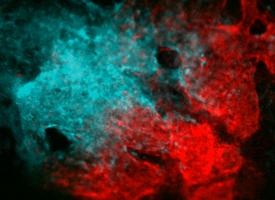
Age-related macular degeneration (AMRD) could be treated by transplanting photoreceptors produced by the directed differentiation of stem cells, thanks to findings published today by Professor Gilbert Bernier of the University of Montreal and its affiliated Maisonneuve-Rosemont Hospital.
ARMD is a common eye problem caused by the loss of cones. Bernier’s team has developed a highly effective in vitro technique for producing light sensitive retina cells from human embryonic stem cells. “Our method has the capacity to differentiate 80% of the stem cells into pure cones,” Professor Gilbert explained. “Within 45 days, the cones that we allowed to grow towards confluence spontaneously formed organised retinal tissue that was 150 microns thick. This has never been achieved before.”
In order to verify the technique, Bernier injected clusters of retinal cells into the eyes of healthy mice. The transplanted photoreceptors migrated naturally within the retina of their host. “Cone transplant represents a therapeutic solution for retinal pathologies caused by the degeneration of photoreceptor cells,” Bernier explained. “To date, it has been difficult to obtain great quantities of human cones.” His discovery offers a way to overcome this problem, offering hope that treatments may be developed for currently non-curable degenerative diseases, like Stargardt disease and ARMD. “Researchers have been trying to achieve this kind of trial for years,” he said. “Thanks to our simple and effective approach, any laboratory in the world will now be able to create masses of photoreceptors. Even if there’s a long way to go before launching clinical trials, this means, in theory, that will be eventually be able to treat countless patients.”
The findings are particularly significant in the light of improving life expectancies and the associated increase in cases of ARMD. ARMD is in fact the greatest cause of blindness amongst people over the age of 50 and affects millions of people worldwide. And as we age, it is more and more difficult to avoid – amongst people over 80, this accelerated aging of the retina affects nearly one in four. People with ARMD gradually lose their perception of colours and details to the point that they can no longer read, write, watch television or even recognize a face.
ARMD is due to the degeneration of the macula, which is the central part of the retina that enables the majority of eyesight. This degeneration is caused by the destruction of the cones and cells in the retinal pigment epithelium (RPE), a tissue that is responsible for the reparation of the visual cells in the retina and for the elimination of cells that are too worn out. However, there is only so much reparation that can be done as we are born with a fixed number of cones. They therefore cannot naturally be replaced. Moreover, as we age, the RPE’s maintenance is less and less effective – waste accumulates, forming deposits. “Differentiating RPE cells is quite easy. But in order to undertake a complete therapy, we need neuronal tissue that links all RPE cells to the cones. That is much more complex to develop,” Bernier explains, noting nonetheless that he believes his research team is up to the challenge.
Bernier has been interested in the genes that code and enable the induction of the retina during embryonic development since completing his PhD in Molecular Biology in 1997. “During my post-doc at the Max-Planck Institute in Germany, I developed the idea that there was a natural molecule that must exist and be capable of forcing embryonic stem cells into becoming cones,” he said. Indeed, bioinformatic analysis led him to predict the existence of a mysterious protein: COCO, a “recombinational” human molecule that is normally expressed within photoreceptors during their development.
In 2001, he launched his laboratory at Maisonneuve-Rosemont Hospital and immediately isolated the molecule. But it took several years of research to demystify the molecular pathways involved in the photoreceptors development mechanism. His latest research shows that in order to create cones, COCO can systematically block all the signalling pathways leading to the differentiation of the other retinal cells in the eye. It’s by uncovering this molecular process that Bernier was able to produce photoreceptors. More specifically, he has produced S-cones, which are photoreceptor prototypes that are found in the most primitive organisms.
Beyond the clinical applications, Professor Bernier’s findings could enable the modelling of human retinal degenerative diseases through the use of induced pluripotent stem cells, offering the possibility of directly testing potential avenues for therapy on the patient’s own tissues.
Read more: Restoring vision with stem cells
The Latest on: Restoring vision with stem cells
[google_news title=”” keyword=”Restoring vision with stem cells” num_posts=”10″ blurb_length=”0″ show_thumb=”left”]
via Google News
The Latest on: Restoring vision with stem cells
- Restoring sight is possible now with optogeneticson April 30, 2024 at 8:31 am
Over time they lose peripheral vision ... sensitivity of cells in the retina, the layer of tissue at the rear of the eyeball. Therapeutic optogenetic therapy for vision restoration certainly ...
- In a first, mice brain circuits regenerated using rat stem cellson April 25, 2024 at 8:29 am
Two independent research teams have achieved successful regeneration of mouse brain circuits by cultivating neurons from rat stem cells.
- Restoring sight is possible now with optogeneticson April 22, 2024 at 11:30 pm
Over time they lose peripheral vision ... cells translate the visual signals into neural information. (Carolyn Fong for The Washington Post) Therapeutic optogenetic therapy for vision restoration ...
- The promise of a miracle cureon April 17, 2024 at 5:00 pm
Doris Tyler was losing her sight, so she tried a new stem cell treatment that changed her ... Doris’ blurry vision was diagnosed as macular degeneration, and it was only getting worse.
- Light-activated neurons from stem cells restore function to paralyzed muscleson April 3, 2024 at 5:00 pm
A new way to artificially control muscles using light, with the potential to restore function to muscles paralysed by ... transplanting specially-designed motor neurons created from stem cells into ...
- Exploring Stem Cell Strategies for Spinal Cord Repairon March 13, 2024 at 11:16 am
Researchers explore promising new stem cell strategies to replace cells, repair the injured spinal cord, and restore lost function. In this webinar brought to you by The Scientist, Stephanie Willerth ...
- The Bionic Eye That Could Restore Vision (and Put Humans in the Matrix)on May 17, 2023 at 5:30 pm
The Bionic Eye That Could Restore Vision (and Put Humans in the Matrix) Story by Jackson Ryan • 10mo ... The idea is to coax other cells within the eye to receive and translate light signals.
- Stem cell therapyon October 11, 2022 at 3:49 am
Using stem cells, it’s possible to generate cells that can support the retina and halt the progression of the disease, possibly even leading to partial restoration of lost vision. Both embryonic stem ...
- Seeking Enlightenment: The Quest To Restore Vision In Humanson December 29, 2020 at 4:48 am
Whether it’s about navigating a busy city or interacting with the countless screens that fill modern life, coping with reduced or no vision is ... to turn every cell into a stem cell.
via Bing News











